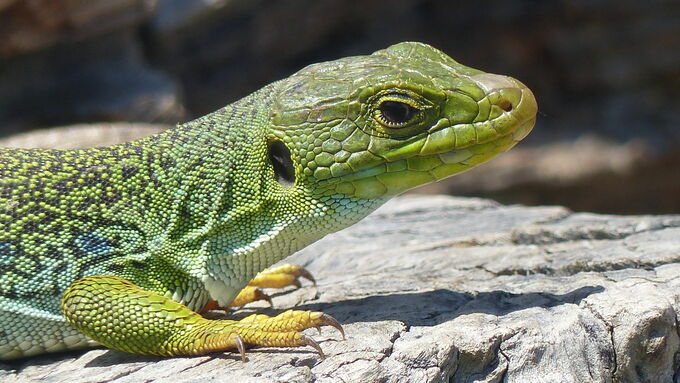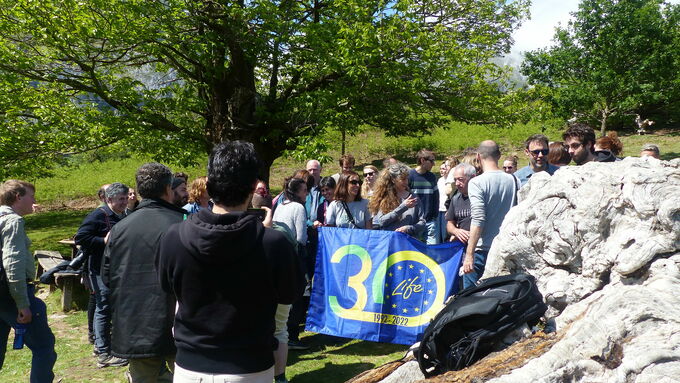The ocellated lizard (Timon lepidus) was the guiding motif of the event and could also be readily observed in the wild. © Martina Raffel
download picturemain content
Project of the month
#06/2024 LIFE Platform Meeting
International networking: Platform Meeting “Amphibian & Reptile Conservation in Europe - Challenges and Opportunities”
More than a hundred experts from all over Europe met in Santander in late May to participate in the LIFE Platform Meeting “Amphibian & Reptile Conservation in Europe”. The LIFE IP Atlantic Region DE also attended the meeting to present the project and in particular the measures taken to reintroduce the common spadefoot toad. The meeting, promoted by the DG Environment of the European Commission and organized by CINEA and the Steps for LIFE project with the Camino Lebaniego Foundation at the helm, addressed crucial issues for the conservation of amphibians and reptiles in Europe. The conclusions obtained from this meeting will be studied for their integration into new herpetofauna conservation policies in Europe.
The following key topics were addressed in the plenary presentations and the working groups:
- Climate change and Protected Areas: Protected areas for amphibians and reptiles in the context of climate change – have we protected the right areas?
- Invasive alien species: Exploring methods and options for removal of species which have to compete with native species.
- Addressing human pressures: Long-term future for amphibians and reptiles considering the increasing pressure on habitats through fragmentation, urbanisation and changing agricultural practices.
- Policy framework: To what extent are amphibians and reptiles taken into account in national and EU policy agendas?
The discussions in the various sessions of the three-day meeting can be summarized as follows: It is crucial to have a minimum level of knowledge about the species and to establish consistent long-term monitoring schemes. This includes the need to increase monitoring of different climate scenarios for the design and management of protected areas with flexibility to allow simpler procedures for expanding boundaries. In addition, the importance of connectivity and the elimination of infrastructure barriers has been highlighted to ensure adequate distances, according to the mobility of the species and greater involvement of local authorities, with respect to the opinions of land owners, combining methods traditional with new conservation techniques. The conclusions also include the need to increase opportunities and resources for the establishment of networks for the exchange of information and best practices, the integration of policies and legislation in different sectors to address legislative and bureaucratic conflicts, as well as the involvement of administrations to ensure their support for it. The need to ensure the sustainability of the impact of the conservation actions carried out was also concluded, once the projects are completed, including subsequent visits and long-term conservation plans. Technology has also been present in the conclusions provided by the working groups. In this way, the need to take advantage of new monitoring techniques (drones, AI, e-DNA) and map environmental pressures to guide interventions has been highlighted. Likewise, the importance of connecting habitats in the landscape and considering the presence of exotic predators has been highlighted, in addition to adopting a holistic and species-specific approach in the restoration of habitats and their reintroduction into them. The working groups also stressed the need to adapt agri-environmental schemes for the conservation of species with restricted ranges and habitats and implement results-based payment schemes to ensure income equality for farmers and landowners. Emphasis has been placed on the protection of suitable microhabitats, recognizing changes under different climate scenarios, promoting conservation as a long-term investment, involving the private sector and avoiding greenwashing and the use of 'favourable conservation status' as a metric for resolving land use conflicts, plus promoting a 'race to the top' in financing areas with favourable status.
Two days of presentations and workshops were followed on the third day by an excursion to various action sites of the host project "Steps for LIFE" along the "Camino Lebaniego" in the Picos de Europa National Park. The first stop was Cicera in the Valle de Peñarrubia where breakfast was served at the Posada de la Valuisilla – a Bed & Breakfast in an old house of typical Cantabrian construction which housed the school in former times. The group then enjoyed the little walk to the Agüeras waterfalls where some of the actions of the project were explained. The second stop was the Santa Catalina viewpoint with spectacular views on the eastern Picos de Europa and some sightings of vultures which nest in the caves and circled over the valley. The third and final stop was at the “Habario de Pendes”, one of the most important sites of mature chestnut trees in Spain. These specimens with centuries of history are guarded by the imposing profile of Peña Ventosa and the Picos de Europa. Here, the feedback session on the workshops of the previous day took place to give all participants an overview of the groups that had not been attended and then to summarise the most important results as conclusions. The extremely successful meeting ended with a subsequent walk through the impressive chestnut grove.
Steps for LIFE
The project aims at transforming the cultural and tourist infrastructures of the Camino Lebaniego and its three branches into versatile green infrastructures which enhance biodiversity, boost ecological connectivity, provide ecosystem services, and increase tourist awareness. The 'Steps for LIFE' work team is coordinated by the Camino Lebaniego Foundation with the Municipal Chamber of Vila Nova de Gaia in Portugal, the International Foundation for the Restoration of Ecosystems (FIRE), the Association Amica (AMICA), the Spanish Society of Ornithology SEO/BirdLife Cantabria (SEO) and the Cantabrian Association in favour of people with intellectual disabilities (AMPROS) as partners.
This text is partly based upon news items and reports on the “Steps for LIFE” and the CINEA websites.





